I debated writing on this topic as the story of the Tu-4 “Bull”; the reverse-engineered B-29 Superfortress; is fairly well known. Numerous authors have covered it, and there was a TV documentary on it some years ago. None the less, the topic is apparently still of high interest, so perhaps the information below will be presented in a different way or otherwise still be of value.
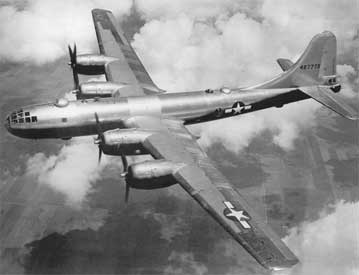
(A Boeing B-29 Superfortress during WWII.)

(A Soviet soldier with WWII-era Mosin-Nagant marches in Red Square in the late 1940s as a Tu-4 “Bull” flies overhead.)

(A RDS-4 atomic bomb is wheeled to a Tu-4 “Bull”.)
The Soviet Union developed any number of highly effective fighters, ground attack planes, trainers, and twin-engined tactical bombers during WWII. One effort where the Soviets were far behind by the end of the war was strategic bombers. During WWII the USSR had only one (relatively) modern four-engined strategic bomber, the Pe-8.

Less than 100 were completed during WWII. They achieved little while suffering horrendous losses. By the time of Japan’s surrender in September 1945 there were only three dozen Pe-8s remaining. When NATO formed in 1949, they were considered so insignificant that they never even received a reporting name.
Throughout WWII, Josef Stalin sought to obtain American strategic bombers via Lend-Lease; with no success. As soon as Soviet intelligence became aware of the B-29 Superfortress, that type was requested as well. In 1944 the USA rejected the request, along with another attempt later that year and a third request in 1945. The USA considered the Superfortress such an advanced weapon that the requests were barely even given consideration.

As an interesting side note, President Roosevelt appended one of the rejections with a “consolation gift” of HNS-1 Hoverfly helicopters. In all countries early during WWII, helicopters were considered frivolous toys at best and an angry Stalin replied that if he could not get B-29s, then he didn’t want HNS-1s either. During the final part of WWII, the US Coast Guard made enthusiastic use of helicopters, as did to a much lesser extent the German Luftwaffe and US Army. In 1945 Stalin notified the USA that he was now ready to begin accepting Hoverflys, only to be told that they were no longer on the table.
The USSR did get it’s hands on several four-engined American bombers in the European theatre of WWII. At least one airworthy B-17 Flying Fortress and two B-24 Liberators were recovered from airfield abandonments during the operation “Frantic” shuttle bombing missions, along with a larger number of both types in barely-flyable or salvage-only condition. The USSR considered the both obsolete by 1945 and not worth reverse-engineering.
the luckless Soviet attempt
For the postwar world Stalin did not want a contemporary of the Flying Fortress, but rather something like the Superfortress: very long-ranged, with a high bombing altitude, and a heavy bomb load.
By September 1943, the Soviet army had pushed retreating German forces back past the Dnieper river in the Ukraine and Stalin was confident enough to start projects not of immediate urgency. That month the Tupolev bureau was tasked with designing a long-range, four-engined strategic bomber.
Simply designated “Samolet (airplane) #64”, the Tupolev design was the opposite of the B-29’s graceful beauty. Over 100′ long, it had strange twin “bug eye” cockpits and long engine nacelles. It was intended for a crew of 10.

(Tupolev PLC company photo)
Samolet #64 underwent many revisions, switching between twin and single rudders, a fishbowl type nose, and various engine proposals. Tupolev encountered design problems throughout: fuel tanks, navigational gear, electrical systems, and so on. Little of this was the bureau’s fault, as necessary production techniques simply didn’t exist in the USSR then.
A wooden mockup was completed eleven days before Germany’s surrender. By then, Stalin had lost interest in Samolet #64. Tupolev kept the project alive as he hoped to finish it as a peacetime airliner, however it went unbuilt and was cancelled in 1947.
B-29s arrive
The Soviet Union interred three B-29 Superfortresses during WWII. Until August 1945, the USSR had a non-aggression pact with Japan. Under international law, warplanes of warring parties landing in a neutral third country are required to be interred for the rest of the conflict.

“Ramp Tramp II” landed near Vladivostok on 29 July 1944, after taking an AA hit during a mission over Manchukuo. The damage was not severe but bad enough to make a return home impossible.

“General H.H. Arnold Special” landed at Tsentral’naya naval airbase on the USSR’s Pacific coast on 11 November 1944, after a storm blew it off course during a raid on the Omura aircraft factory in Japan.

“Ding Hao” landed at the same place ten days later after a Japanese AA round hit one of it’s engines. Of the three, it was the most significantly damaged.
All three of these B-29s were airworthy. Additionally the Soviets got pieces of four others: On 20 August 1944, “Cait Paomat II” crashed in eastern Russia, followed a day later by “What Happened” which ditched in a very remote Siberian forest with heavy AA damage. It took several weeks for Soviet troops to rescue the crew; thereafter they helped themselves to anything intact at the crash site. During the final week of WWII, when the USSR was at war with Japan, two B-29s were accidentally shot down by Yak-9 fighters over northern Korea. The crewmen of “Hog Wild” and “Buckin Bronc” were immediately freed and eventually, the USSR notified the USA of the crash sites, which by then were picked over.

(Soviet Naval Aviation personnel surround one of the B-29s, most likely “Ramp Tramp II”.)
the Tu-4 project starts
The idea for reverse-engineering the B-29 came not from Andrei Tupolev’s bureau, but rather from Vladimir Myasischchev, who ran his own aircraft design bureau. After the third B-29 was secured during WWII, Myasischchev suggested to Stalin that it would be both feasible and advantageous to reverse-engineer it. Stalin agreed, but for whatever reason, assigned the effort to his rival Tupolev in June 1945.

(One of the planes, probably “General H.H. Arnold Special”, being inspected by Soviet officials.)
After being informed of the plan, Andrei Tupolev told Stalin that it was likely to succeed, and that 4 – 5 years would be required. Stalin replied with his “three commands” that dictated the rest of the project:
- The project would be completed in 2 years, not 4 or 5.
- It was to be an exact copy of the B-29, in every single regard. No deviations or changes would be allowed. In Stalin’s logic, this was to prevent Tupolev from dragging the effort out to adapt American technology to his own designs.
- Tupolev would have unlimited resources. The B-29 project was placed in higher priority than anything else in the Soviet military, less the ongoing a-bomb effort. Stalin also told Tupolev that he had personal interest in the B-29 and would support the project, and also that he would personally deal with anybody who delayed the project.
Tupolev’s first step was collecting the three B-29s. As they were technically in custody of the Soviet navy, they were staged at Romanovka naval airbase and then flown across 10 time zones to Izmailovo Naval Test Centre near Moscow. A pilot named Lt. Seymon Reidel was selected for both the ferry flights and early test flights. Lt. Reidel had previously flown Lend-Leased American tactical bombers, and was bilingual. He delivered “Ramp Tramp II” first, in June 1945. Reidel selected this plane as it’s condition was not quite as good as “General H.H. Arnold Special” but better than “Ding Hao”. He reasoned that if this plane crashed on the first flight, the best one would still be available. On “Ramp Tramp II”, Reidel personally translated every placard, label, and gauge from English into Russian.

(“Ding Hao” with Soviet insignia.)
Once all three B-29s were near Moscow, the reverse-engineering could begin. Regarding the three planes: “General H.H. Arnold Special” was selected as the dissection aircraft. “Ding Hao” was to be kept grounded as the reference example, and as a spare in case something went wrong with the dissection. “Ramp Tramp II” was to be kept flying, so a pilot’s manual could be authored. It was assigned to the 890th Aviation Regiment, which during WWII had flown Pe-8s and Lend-Leased B-25 Mitchells, and was also the short-lived evaluation home for one of the abandoned B-17 Flying Fortresses.
THE DISSECTION
One might assume that physically taking “General H.H. Arnold Special” apart was the easiest step of this monumental job, but it certainly was not. Essentially, since the Soviets didn’t know what made up a B-29, the plane’s dissection was doing a puzzle without knowing what the end result was supposed to look like.

(“General H.H. Arnold Special” being dissected.)
Every single step of the way, each part had to carefully and non-destructively be extracted, first to determine if it was even a part itself or rather a subassembly of smaller parts, then done in a way that left it completely unaltered for measurement.

(“General H.H. Arnold Special” being dissected.)
inch vs metric
The Tupolev bureau knew ahead of time what one of their biggest headaches would be. Before WWII, the USSR bought limited rights to Douglas’s DC-3 airliner. Led by engineer Boris Lisunov, a near-clone called the Li-2 “Cab” was produced and served throughout WWII and long after. A severe problem Lisunov encountered was converting parts made in inches to millimeters, pounds to kilograms, etc.
With the B-29, in some cases it was impossible. For example 1/16″ gauge aluminum, a common size at Boeing, equates to 1.5875mm. No metal factory in the USSR made such an odd gauge and even if they could, checking tolerances with metric tools would have required instruments with precision down to the fifth decimal. The closest Soviet matches were two gauges of D-16T aviation-grade duralumin. One was 1.5mm and the other 1.6mm. Here, the 1.5mm was too weak in certain applications while 1.6mm would have cumulatively pushed the Tu-4 overweight if used throughout. The Tupolev bureau adopted a “case-by-case” approach and thus, significant time was spent deciding which parts would be made of which gauge of metal. About 1% of the Tu-4’s total weight was calculated as being necessary increases due to inch vs metric.
sizing
“General H.H. Arnold Special” was not factory fresh, having flown 29 missions during WWII before it’s ownership change. Things like wing spars, fuselage joints, etc had flexed, expanded, and contracted. The Soviets first had to estimate how much, if any, of a part’s size was distortion, and then backwards-calculate it out to come up with a true measurement.
copying
One problem was that the Soviets obviously lacked a Boeing parts checklist, so they had no way to be certain if they’d taken everything apart in a way that could then be manufactured. The Tupolev team eventually decided that a B-29 had roughly 105,000 different “parts”, of which there were about 380,900 subcomponents plus over 910,000 individual “fasteners” (bolts, washers, rivets, screws, nuts, clamps, etc).

(The blueprint team at work.)
Blueprint makers worked around the clock, completing 40,000 A4-sized blueprints. There was also a team of artists, often working during the night shift when less physical disassembly was happening, who drew sketches of everything.

(Sketches prepared of the various seat designs Boeing used in the B-29.)
deviations – planned, and otherwise
Stalin’s foremost order was “no deviations” from the American original. This was indeed followed throughout, but naturally the Tu-4 ended up not quite exactly the same.
engines
Before the project even started, Tupolev told Stalin that he could have a copy of the bomber in two years, or a copy of the Wright R-3350 engine in two years, but not both. Surprisingly, Stalin agreed and ordered a Soviet engine be substituted. The engine chosen was the Shvetsov ASh-73. Like the R-3350, the ASh-73 was an air-cooled 18-cylinder radial. The Soviet engine had about 300hp more than the American as each cylinder displaced 6% more, but this was partially counteracted by its own larger overall size.
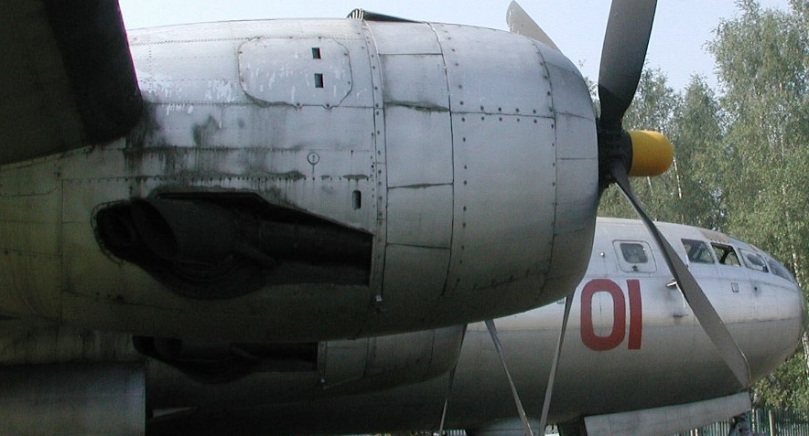
(The Shvetsov ASh-73 on a Tu-4.)
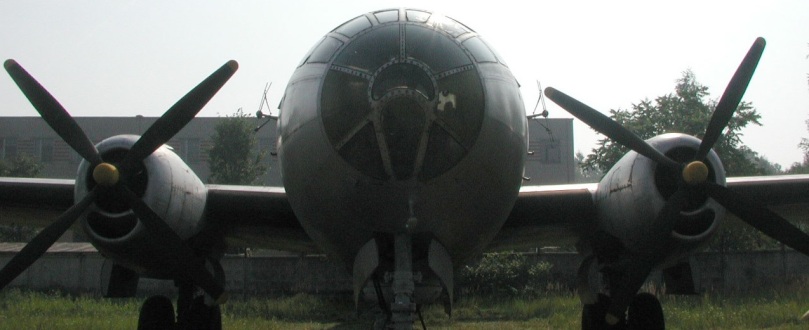
(The airscoops on the nacelle undersides served oil coolers. The ASh-73 itself had no radiator.)
defensive guns
The USSR already obtained examples of the AN/M2 aircraft .50cal machine gun during WWII, but the postwar Soviet military was not keen on introducing a new machine gun and ammo into production.
Without any prompting, Stalin decreed that Soviet weapons be substituted. This was naturally a welcome relief overall but ended up causing minor issues in the short term. The gun chosen was the Berezin B-20, a WWII autocannon firing the 20x99mm Soviet cartridge at 800rpm.

Placement of the B-20s mimicked that of the .50cals on the B-29; two upper and two lower remote-controlled turrets and a twin manned tail gun (it was originally planned to make the tail gun a triple, and some Tu-4s were completed this way). The ammunition per twin station was 840rds, except the tail gun which had 1,700rds. Because of the B-20’s shape, the Boeing tail gunner position could not be replicated. The Soviet design rotated 30° off centreline and had ±29° elevation.

During the Tu-4’s production run, the gun type was changed to a Cold War-era model, the Nudelman-Rikhter NR-23, seen below. This gun fired the 23×115 Soviet cartridge. The change was mainly to achieve commonality with 23mm guns on other Cold War bombers.

The B-29’s General Electric central gunfire control computer was faithfully copied. This actually ended up being one of the most difficult parts of the whole reverse-engineering; it was so advanced in the late 1940s that to the Soviets, it must have seemed like science fiction.
A problem the computer caused (which Tupolev’s team obviously had no way of knowing) was that General Electric specifically designed the computer around the 50BMG cartridge. The different ballistic drop and muzzle velocity of the Soviet 20mm and 23mm rounds caused constant logic errors, which often “locked up” the computer and hence all the plane’s turrets. This was not resolved until 1950.
electronics
An issue was that if the American radios were exactly copied, the Tu-4 would fly with communications partially incompatible with the rest of the Soviet military. A compromise was worked out. The AN/ART-13 transmitter was copied as the R-807 Berkut. Meanwhile the receiver portion of the radio used Soviet gear.
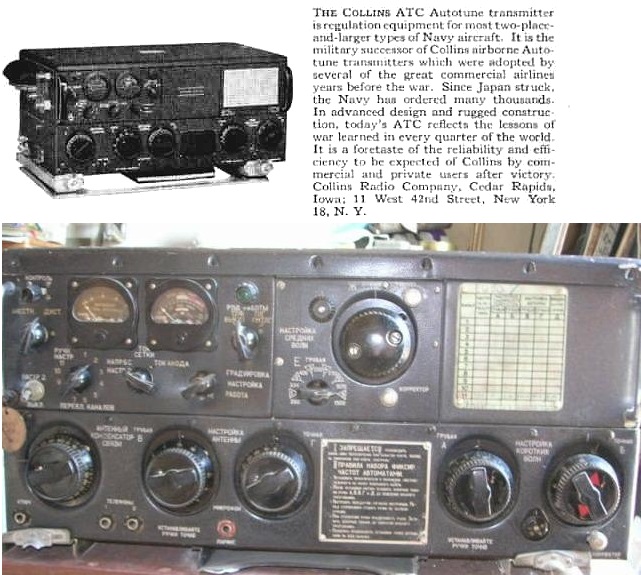
(The AN/ART-13 and it’s copy, the R-807 Berkut.)
For the B-29’s AN/APQ-13 bombing radar, a similar question emerged, in that an exact copy could likely be easily countered by the country that designed the original during WWII. The Tu-4’s Kobal’t radar was a melding of copied American and original Soviet systems, with the Kremlin’s approval.
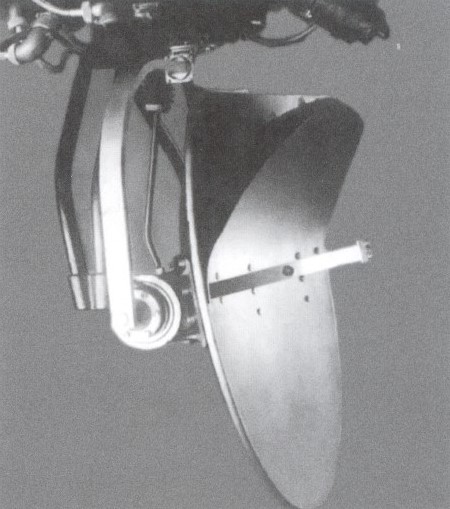
The Kobal’t could not pick out individual buildings but by cross-referencing coastlines, hills, etc to a map; specific targets could be attacked at night or in bad weather with some accuracy, at least by early Cold War standards.

cameras
Because of a then-shortage of reconnaissance planes, each Tu-4 was completed with an AFA-33 camera. Every third plane off the assembly line also had a NAFA-3S/50 night camera which worked in cooperation with FOTAB-series flashes, carried in place of one or more bombs.
“quiet” deviations
The things listed above were allowed changes. With other dilemmas, Tupolev rolled the dice and quietly made changes on his own, without approval.
One problem was the bomb bays and their contents. In theory, a Tu-4 with an exact copy of the B-29’s bomb bays had exactly the same 20,000 lbs (9,071½ kg) warload. However since individual Soviet bombs were sized in kilograms and centimeters, this did not work out, and only 13,228 lbs (6,000 kg) could fit. Tupulev decided to report the theoretical, not usable, maximum as a match. Nobody ever asked any questions and after Stalin later grew bored with the “Bull” project, Tupolev designed a new rack to bring the capacity back up to the airframe’s maximum.
One of the most mundane changes was the wiring. The B-29’s electrical system was challenging to reverse-engineer. Tupolev himself described the Superfortress as a logical airframe dropped into a spiderweb of electrical wire. Once the length, diameter, and voltage of the thousands of wires was determined, a decision had to be made as to how far Stalin’s “exact copy” command went. On his own, Tupolev decided to use Soviet wires of appropriate diameter and voltage instead of wasting weeks on detailed metallurgy studies. Every Tu-4 had a difference of a few pounds weight due to the copper content in American vs Soviet wires.
Tupolev also made minor changes to the fuel tank arrangement to save time, and substituted natural glass for the nose plexiglass after Soviet industry failed to copy the American material.
All of this shouldn’t leave one with an impression that Tupolev was trying to “bend the rules”, to the contrary he followed Stalin’s “exact copy” command as strictly as possible. At one point he inquired if he should reverse-engineer the American aircrew’s parachutes. (A general in Moscow replied that Soviet parachutes were acceptable). As another example, a crewman’s thermos left aboard one of the B-29s was reverse-engineered and issued with each “Bull”.
One of “General H.H. Arnold Special”s wings had a tiny hole which was obviously intentionally drilled and not battle damage. The Soviets wracked their minds trying to determine what the inexplicable hole was supposed to accomplish. Eventually, Andrei Tupolev told them to remember Stalin’s order, and every Tu-4 had one tiny hole drilled in one wing. In the 1990s, the modern Tupolev company asked Boeing what the hole’s task was. They replied that it was probably a manufacturing flaw on that one particular B-29.
the tires
The saga of the Tu-4’s earliest tires was an incredible story almost more unbelievable than the whole plane itself.

(Nose gear of a Tu-4 “Bull”.)
The Superfortress used 3′ diameter Goodyear 16-ply synthetic rubber tires on the nose gear and 4’8″ diameter Firestones on the main undercarriage. These tires took a pounding. They bore up to a 67½ ton load at takeoff, then were exposed to very cold temperatures and low external pressures at bombing altitude, and finally intense friction (the big B-29 landed around 110mph) at the mission’s end. The nosewheels in particular took a strain; during hard runway braking the B-29’s mathematical centre-of-gravity moved to an imaginary spot slightly ahead of the aircraft.
In 1946 – 1947, the USSR’s rubber industry was still geared mostly to mass manufacture of cheap WWII truck tires and was nowhere near where it needed to be for tires like this. (The “Bull” was not the only affected high-end aircraft; Yak-15 “Feather” jet fighters briefly had a prohibition on taxiing under power to preserve their tires.)
After Tu-4 production had already started, tires were still being made in a trial-and-error fashion, one by one. This was barely sufficient for the first batch of planes and far insufficient to keep multiple squadrons running.
True to his 1945 pledge of support to Tupolev, in late 1946 Stalin ordered Soviet intelligence to covertly get B-29 tires wherever they might be found around the world. This was to be done by establishing bogus surplus companies to buy them. The efforts were directed around former B-29 bases in India (which became independent in 1947), China (now in a civil war) – especially the airbases at Luliang and Chengkung -, and finally inside occupied Japan. Quite remarkably there was also a project to buy and export B-29 tires inside the USA itself. Some of these efforts were broken up by American intelligence, but apparently at least enough used B-29 tires made it to the USSR until Soviet industry mastered the skills in the late 1940s.
conclusion of the effort
At it’s peak, the Tu-4 project involved over 900 subcontractors and 60 state committees. A radio network was established between major factories involved for real-time updates. By Christmas Day 1946, a full-size wood mock-up was ready. In February 1947, only 20 months after the B-29 reverse-engineering started, the very first Tu-4 “Bull” was finished. Twenty production Tu-4’s were immediately ordered even before flight tests started.
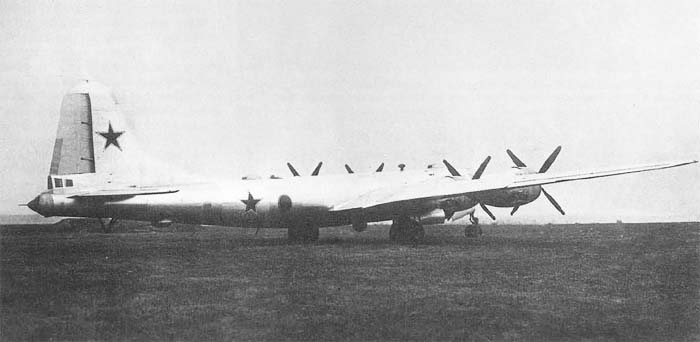
(The very first Tu-4 completed.)
“Ramp Tramp II” was re-engined with ASh-73s and kept in service to familiarize prospective Tu-4 crewmen. It flew until 1954. The final fate of “Ding Hao” is uncertain.
Flight tests ran through 1947. By 1948, ten Tu-4s had been delivered to operational squadrons with more in the pipeline. The first frontline unit, the 185th Guards Air Regiment, wholly converted to the Tu-4 at Poltava airbase on 11 April 1949.

(Tu-4 bombers flying over Moscow.)
secrecy
In 1946, an executive of PanAm Airlines returning from Moscow said an acquaintance in the Soviet military had shown him photos of a B-29 Superfortress in Soviet markings. This is not unbelievable. From the 1940s through the 1980s, the Soviet Union had an odd tendency from time to time to reveal military hardware (not just planes) to visiting western civilians before mainstream defense publications or foreign officials.
By that year the United States was already aware of the project. The first concrete proof of it’s success came in August 1947, when three flew together in an air display to which foreign military attaches (including the USA’s) were invited.

(An American spy plane photo of Tu-4 “Bull”s at Khorol airbase in the USSR.)
DESCRIPTION

Little needs to be said about the Tu-4 “Bull” as, other than differences noted earlier, it was exactly the same as a B-29. The basic bomber version was simply designated Tu-4. Other versions, some rebuilds of existing airframes, are listed below.
Tu-4: The basic bomber version.

(Bombardier’s position on a Tu-4. Norden bombsights were intact on the three B-29s, however the USSR already had gained access to the Norden by then anyways.)
Tu-4R: The reconnaissance version. The fuel load was increased to 24½ tons but non-essential equipment was removed, meaning the plane was faster and could fly higher and further than a regular “Bull”. These were all conversions of existing Tu-4s.

(In the upper right is a Tu-4R, with it’s nose under canvas, attached as the post-strike assessment plane to a Mya-4 “Bison” squadron.)
Tu-4REP: The electronic warfare version. These were also conversions of existing Tu-4s. For many years it was thought that this was a minor version, but it’s now known that there was at least one whole unit, the 202nd Technical Bomber Regiment at Mirgorod, operational in 1952.
Tu-4A: This was the atomic bomb version. They are discussed more below.

(The Tu-4A was indistinguishable from a conventional Tu-4 externally.)
Tu-4K: Operated by the Soviet Navy, 50 of these missile carriers were built new. They were optimized for anti-ship missile attacks. In 1951, Soviet Naval Aviation explored the possibility of attacking American warships beyond the range of WWII-era AA guns. The USSR’s first plane-launched anti-ship missile, the KS-1 Kometa (comet) was developed. More known in the west by it’s NATO reporting name AS-1 “Kennel”, the weapon was essentially an unmanned jet airplane. It was designed jointly by the Raduga rocket bureau and the MiG fighter bureau.

The “Bull”s radar was modified to a new type and an external pylon was sited under each wing. The “Kennel” weighed 3¼ tons and had a 15’7″ wingspan. It was powered by a jet and was subsonic, at Mach 0.9.

A “Kennel” attack involved the Tu-4K acquiring a radar lock on the targeted warship around 40 NM distance. (The missile itself had a maximum range of 56 NM, which the “Bull” could not fully utilize.) After launch, the missile flew via a datalink lock to the “Bull”, until it was roughly 20 NM from the target. This required the plane to remain headed towards the target. The missile then switched to it’s onboard nose radar for the last leg, at which time the Tu-4K could turn away.

Two regiments of the Black Sea Fleet flew Tu-4Ks from late 1952 until 1958. They were replaced by the Tu-16KS “Bagder-B”, a more survivable jet which could also use the “Kennel”s full range potential. The missiles served until 1969.
Tu-4D / Tu-4T: These were the transport versions, of which 301 were made or converted and described further below.
Tu-4LL: Towards the end of the “Bull”s career, some were adapted as testbeds for various projects. Six Tu-4LLs were used as motherships for La-17 target drones to train anti-aircraft crews.

One Tu-4LL served as the mothership of the DFS 346. During WWII, the Luftwaffe intended this unarmed plane to be the first Mach 1 aircraft in history. The untested prototype was captured intact in 1945. The USSR deemed it unflyable by then but a copy was made. It was fast (Mach 0.95+) but never quite went supersonic.
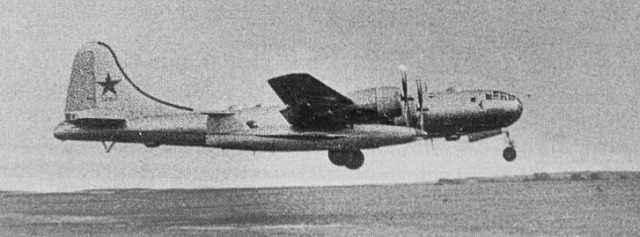
the basic bomber version in service
Three factories built Tu-4 “Bull”s with over 1,000 being completed.
As might be expected, there were mishaps. The first crash was in October 1947 (it was the third airframe completed) followed by another five weeks later. Accidents happened with some frequency, in particular the nose gear buckling and/or propellers striking the runway. This was in part to unfamiliarity with such a heavy plane; and in part to the USSR’s continued use of WWII-era grass airstrips.
Oddly, just like the B-29, the Tu-4 had many engine fires, even though it had different engines.

(Tu-4 operating off a grass airstrip.)
In May 1949, a “unified bombing system” replaced the direct copy of the WWII American bomb racks. This could be quickly reconfigured into four different layouts for numerous warloads of differing kinds of conventional bombs. The FAB-250M-46 bomb, a post-WWII design, replaced wartime-vintage bombs as the preferred ordnance with 42 of these 552 lbs HE bombs being a standard loadout. The Tu-4 could instead carry four larger FAB-3000M-46 bombs or even two gigantic FAB-6000 6½-ton weapons.

(FAB-250M-46, the Tu-4’s standard bomb type.)

(The big FAB-3000M-46.)
The original American propellers, which were designated VZ-AZ during the reverse-engineering, were replaced by the Soviet VZB-A5 design. The electronics were also updated.
One very unusual idea was a proposal to replace the tail guns with two AA-1 “Alkali” air-to-air missiles facing backwards on mini-pylons underneath the horizontal tails. They would be served by a rearward-facing radar in the former tail gunner’s spot, targeting enemy fighters chasing the “Bull”. This idea never made it to squadron service.

(Rearwards-wiring proposal for the AA-1 “Alkali” missile.)
After Germany surrendered in May 1945, the USSR gained access to the V-1 buzz bomb. The Tu-4 seemed to make an ideal mount for this early cruise missile, and V-1 copies (designated 10Kh) were tested, followed by a twin-engine Soviet version, the 16Kh. In February 1953, Stalin cancelled all V-1 derivatives as they were incapable of accepting a nuclear warhead.

(16Kh missiles on a Tu-4.)
As the Tu-4’s usefulness as a bomber waned, a proposal was made to use it as a “flying SAM site”. Here, one Tu-4LL was modified to carry a SA-1 “Guild” surface-to-air missile (designated G-300 for the tests) as an effort to extend the range of the USSR’s ground-based air defenses. The Tu-4LL didn’t do anything except physically drop the missile; the detection and guidance phases were all done by ground-based radars. The concept was that American bombers could be shot down further away from SAM sites. In 1952 – 1953, 17 flights including 7 firings were done. While the V-300 ground-based SA-1 “Guild” was accepted, the G-300 air leg was cancelled in 1954.

(Test of a G-300 missile.)
THE “BULL” AND THE SOVIET A-BOMB
During WWII Lt. Georgy Flyorov, a prewar scientist, noticed that scholarly publications on atomic physics in Great Britain and the USA had abruptly ceased and notified his command that this was maybe of interest. Lt. Flyorov’s observation made it to Moscow and it definitely was of interest. GRU (the USSR’s WWII foreign intelligence service) penetrated the Manhattan Project, mainly through Klaus Fuchs and Theodore Hall.
In 1942, Josef Stalin issued Resolution 2352 which started an atomic bomb project “….to expenses as actual, without regard to estimates” or in other words, a blank check. The effort was de facto headed by the monstrous Lavrentiy Beria of the NKVD. Beria split the effort, with the OKB-11 design bureau cooperating with Manhattan Project espionage, and a smaller all-Soviet effort.
the Tu-4A
Just like the B-29 Superfortress in the USA, it’s widely assumed that pairing the Tu-4 “Bull” with an atomic bomb was a quick “plug-&-play” setup. This is not true and far from it, tremendous challenges were encountered. Just like “silverplate B-29s” in the US Air Force, only certain Tu-4s were initially compatible.

(Anti-flash goggles issued to Tu-4A crewmen.)
Only ten Tu-4A bombers were made; three conversions of regular Tu-4s and seven new-built planes. The bomb bays were gutted, and in place of the regular racks, metal rings shaped like the outside of an atomic bomb were installed. A special radio was installed to command-detonate the bomb in case both its primary and backup fuzes failed; the logic being to prevent a dud from falling into enemy hands.
These planes served from 1949 – 1954.
RDS-1

This was the first Soviet a-bomb, test-detonated on a 123′ tower on 29 August 1949. Because of the espionage, the USSR finished designing the weapon four months after WWII, however work was held up by the need to enrich enough uranium.
The designation RDS was a security cover, supposedly an acronym of Special Jet Engine in Russian, also jokingly credited inside the Soviet military as “Russia Made It” or “Firetruck Of Stalin”. In the USA it was called “Joe-1″.
RDS-1 was a 22kT implosion-principle device (not surprisingly) similar to the USA’s Mk3 dropped on Nagasaki. It was 12’2″ long and 4’10” at it’s widest point, weighing 4½ tons.
The Tu-4A was specifically designed around one RDS-1 and could carry no bombs of any other type. Conversely RDS-1 was shaped for the Tu-4A and no other bomber could carry one.
Thirty RDS-1s were built between 1949 – 1951. Of these, one was expended in the ground test, and two dozen apparently not fully cored and/or fuzed, with the remaining five at “ready use status” supposedly. However after the collapse of the USSR in 1991, long-retired “Bull” pilots recollected that they had never even seen a warshot RDS-1. Indeed in the late 1990s, the Russian Federation military stated that all had been withheld at the Arzamas-16 facility at Sarov.
RDS-1 was retired in 1954 with the last Tu-4A as nothing else could drop them.
RDS-2

(photo via militaryrussia website)
This was the result of the all-Soviet team’s efforts, and was completed two years later than the espionage-assisted RDS-1. RDS-2 was of the plutonium impacting-mass (“gun principle”) style, and was a 38kT weapon. Based on modern Russian accounts it was difficult to assemble, and of dubious quality.
With a two-year gap since the RDS-1 test, Stalin was adamant that the Soviet Union illustrate an ability to deliver a usable, air-dropped weapon. However a live drop off a plane is more challenging than a tower test and if it failed, perhaps the USA would assume the 1949 blast was a fluke or trick of some sort.
As a compromise, on 24 September 1951 a Tu-4A flew over the tower and used it’s special radio to command-detonate the first RDS-2. As a sidenote, the radiation precautions were atrocious. Scientists on the ground spent half an hour only 880 yards from ground zero, even though this was the second ground detonation in two years at the same spot.
Only eight (including the one tested) RDS-2s were built. Because Tu-4As would require rebuilds to drop it, none were issued operationally.
RDS-3

(digital artwork via Global Security website)
A composite uranium / plutonium implosion-type weapon, RDS-3 was the first atomic bomb actually dropped out of a “Bull”. Similar to RDS-1 externally, one Tu-4A was modified with makeshift spacers to perform the drops.
The first RDS-3 was completed in 1953. On 18 October 1953 a Tu-4 dropped it about 1½ miles from the spot of the RDS-1 and RDS-2 blasts. The yield was less than expected and the test was considered a failure.
After modifications, another RDS-3 was dropped by the Tu-4A on 23 October 1954. Here, Soviet generals wanted a realistic test; in that the Tu-4A flew a combat-type profile at 31,000′ in overcast skies. The blast was unexpectedly strong (62kT). A technical success, this test was a human disaster as a rainshower brought massive fallout down onto the region. (In 2019, a small areas of Kazakhstan are still radioactive from this test.)
Sixteen RDS-3s were built including the two dropped by Tu-4s. They were issued to jet bomber squadrons and frontline Tu-4 “Bull” units were excluded.
RDS-4

Nicknamed “Tatiana”, RDS-4 marked the break from needing to pair specific weapons with specific airframes. The RDS-4 could be carried by a variety of planes including normal Tu-4 “Bull”s. It was a plutonium implosion-type weapon of 30kT yield weighing 2,645 lbs.
The second RDS-4 test was done by a Tu-4 “Bull” on 14 September 1954. This was the final atomic weapon carried by the type, which was already relegated to second-line service. As far as the RDS-4, about 100 were built and they remained in service until 1979.
ability of the “Bull” to deliver an atomic bomb
From airbases in the western USSR, the Tu-4A could deliver an atomic bomb to any of the original 1949 NATO capital cities in Europe. In the eastern USSR, any of the American facilities in Japan and South Korea could have been hit, in addition to British Hong Kong. The Tu-4A did not have enough combat radius to strike any part of the USA (except remote parts of Alaska) and return home.
Little thought was ever given to basing “Bull”s in Warsaw Pact countries, as the added range would have still not put the USA into range. None the less, sometimes Tu-4s would visit Poland, Czechoslovakia, or Hungary to make this seem a viable plan.
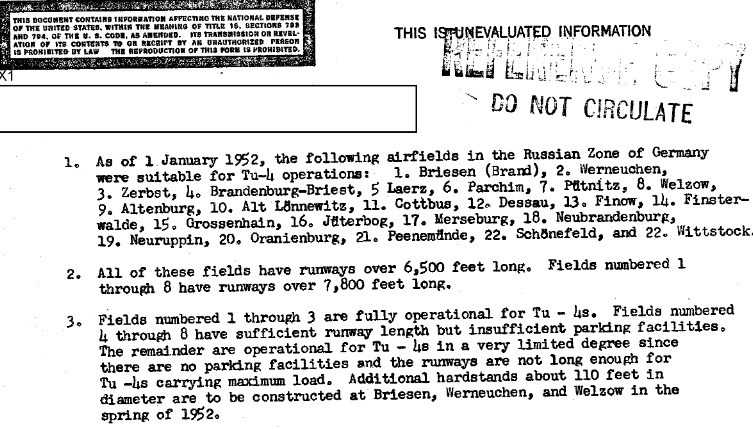
(Declassified in 2006, this 1950s CIA document studied ex-Luftwaffe bases of WWII in East Germany which would be suitable for Tu-4 use.)
While the USSR to getting its hands on B-29s was quite unfortunate, the American military establishment made the most out of a bad situation and hyped the possibility of one-way nuclear suicide missions when lobbying for new air defenses in the 1950s. Assuming this was ever even considered in the Soviet Union (there is no indication it was), airbases in Karelia, Siberia, and Kamchatka would have put certain North American targets (Boston, Seattle, Toronto) in range with additional cities (Detroit, NYC, Minneapolis, Milwaukee, Chicago, Portland) on the fringes.
TRANSPORT VERSIONS
One new plane was completed as the Tu-4T, a pressurized 42-man paratrooper plane. Successful from a technical standpoint, it was too expensive and no more were made. The plane was later used for the USSR’s contribution to the International Ice Patrol.

(Demilitarized “Bull” in Soviet Polar Aviation markings.)
From 1954 onwards, fifty basic Tu-4 bombers were converted into Tu-4D freight carriers. The subdesignation came from Desahntny’y, the Soviet army term for riding on the outside of a tank. The bomb racks were deleted and the bays reconfigured to deliver cargo via PDMM-47 parachutes. These held 33 lbs and up to 168 could be carried. Alternatively 28 paratroopers could be carried (jumping through the bomb bay doors), or mixed cargo and soldiers.

A BD-5-4D pylon was fitted under each wing for cargo pods. These could be para-dropped if necessary, but ideally the Tu-4D would find a place to land and unload them on the ground. The common P-90 pod held up to 3,528 lbs, including WWII-era artillery and light vehicles. The pods caused a 67 kts speed and 5,050′ ceiling loss.

(A P-90 “tailored” for the ZiS-2 anti-tank gun, a WWII item that saw some postwar use.)

(A GAZ-69 jeep inside a P-90.)
The P-98 was a refinement, oriented backwards so that there was no need to cut openings specific to certain loads.

(The P-98 universal pod.)

(P-98 pod being dropped, with the parachute deployment beginning. If possible, it was preferred to land and unload it on the ground. The Tu-4D could simultaneously drop PDMM-47 small supply cans, or paratroopers, from the bays along with the pods.)
Almost completely ignored today, the Tu-4T was a tremendous air assault asset and maybe the most successful of all “Bull” versions.
the Tu-70 / Tu-75 “Cart”

(The Tu-70 “Cart” under construction.)

(The Tu-70’s fuselage being moved into a hangar to be mated with pieces of “General H.H. Arnold Special”. In the background is “Ding Hao”.)
After bombers, Andrei Tupolev’s other passion was airliners, and as soon as he saw the B-29s in 1945 he wanted to adapt their technology to postwar civilian use. The Tu-70 “Cart” was to be made in two versions, a VIP version for 40 passengers in Stateroom- and First-Class seating, and a normal version for 72 passengers in mixed First- and Economy-Class.
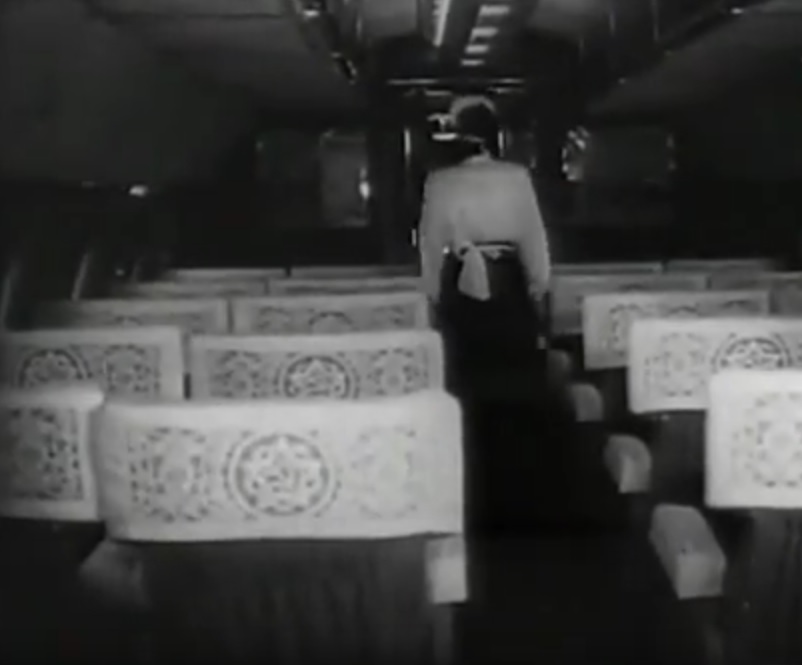
(Passenger seating aboard the “Cart”, which would have compared nicely with any American or British airline.)
To illustrate the link between the Tu-70 and the B-29, Andrei Tupolev ordered pieces of “General H.H. Arnold Special” reassembled into the prototype Tu-70’s wings and landing gear. In 1946, the prototype flew and Tuplolev lobbied the Kremlin to order twenty for Aeroflot, with hopes of other orders later. However Aeroflot felt that there was not enough of a market for this big of an airliner, and that chances of it competing with the Boeing 377 internationally were dim. The lone “Cart” served as a VIP transport until 1954.

(An American assessment of the Tu-70 from 1951.)
Tupolev also proposed an armed military cargo version, the Tu-75, which was also cancelled.

(The never-built Tu-75.)
BURLAKI PROJECT
Burlaki, or “boatmen”, were laborers in old Russia who pulled barges through canals.
The idea of carrying little planes with big ones was not new. During the very first months after the German invasion of WWII, the USSR paired old TB-3 bombers with I-16 fighters, to dismal results.

After the MiG-15 “Fagot” fighter entered service in 1949, the Soviets sought to make this short-range interceptor useful as a defender of long-range Tu-4 “Bull”s. In concept, a small number of “parent” Tu-4s towing “child” MiG-15s would be mixed in with larger numbers of straight bomber Tu-4s, being released and retrieved to guard the whole lot from enemy fighters as needed.
The test “child” was the prototype Yak-25E-I, a losing contender to the La-15 and MiG-15; and the test “parent” was a B-25 Mitchell from WWII Lend-Lease. Both were considered expendable if something went wrong. Nine successful mating / separation sequences were done and Burlaki was approved for development.

(The prototype “child”, the Yak-25E-I, prepares to mate.)

(The test “parent”, a B-25 Mitchell, streams the prototype gear from the former tail gun spot.)

(Diagram of the prototype system.)
Developed by the Yakovlev fighter bureau for Tupolev and MiG planes (the Soviet system didn’t have to worry about corporate secrets), Burlaki consisted of two parts. In the “parent” Tu-4 was a cable drum streaming out of the tail, ended with a cone housing the mating gear. This was streamed 160 yards to the “Bull”s tail.

(The cone at the end of the Tu-4’s cable, here after being successfully “shot” by the proboscis out of the MiG-15’s garpun system.)
On the “child” MiG-15, a device called garpun (harpoon) was fitted to the nose in place of the gun camera. It used compressed air to “shoot” a proboscis into the cone’s center, engaging a lock on the mating gear. Once accomplished, the proboscis – now locked onto the Tu-4’s cone – retracted back inside the garpun, pulling the cone snug to the fighter, which shut down its engine. The Tu-4 then winched the fighter in to 85 yards away and towed it like a glider.

(Garpun-equipped MiG-15 fighters.)
If enemy fighters were encountered, the MiG-15 pilot used a device designated ST2-48 to restart his engine and the Tu-4 disengaged the lock. The MiG-15 had enough air for five extension / retractions of the proboscis, or, two matings and unmatings plus a few “missed shots” at the cone.
Surprisingly there were no mechanical or safety problems with Burlaki. The cone had ±20° of play to avoid whipsnapping the towed fighter, and the Tu-4 could fully maneuver with a MiG-15 in tow (less a 25 kts speed loss). Other than the garpun and ST2-48, no changes were needed to the fighter. The reasons for Burlaki’s failure were not scientific but rather practical.
At high altitude, the MiG-15 pilot would freeze to death with his engine shut off. Yakovlev was studying a way to run the heater via offboard electricity through the cable when Burlaki was cancelled.
Mikoyan-Gurevich designed the MiG-15 with enough onboard oxygen to fly it’s full range at it’s slowest speed. However under tow, the fighter would be airborne much longer. That problem was never resolved.
An airfield obviously never moves on a map, but the Tu-4 would be moving at 300mph and maybe maneuvering. After a dogfight, the MiG-15 pilot would have to mentally retrace his steps to find the Tu-4 again.
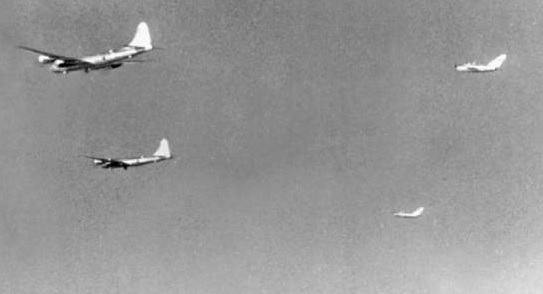
(Burlaki system in use.)
During the summer of 1952, an exercise at Ziabrovka airbase simulated opposed use of Burlaki. Unmodified MiG-15s flew the role of aggressors, instructed to simulate characteristics of the USAF’s F-89 Scorpion. Crewmen in the Tu-4 only spotted the incoming “Scorpions” when they were 5½ miles away. A real F-89 could close that entire distance in 25 seconds and be within weapons range in 14 seconds. There was simply not enough time for the “Bull” crew to humanly identify the threat, have the MiG-15 pilot restart his engine, and disengage the Burlaki.
Five Tu-4s and six MiG-15s received Burlaki gear. From 1951 – 1952, a total of 142 test flights (including 18 at night) were made, including one with the MiG-15 under tow for 2½ hours. The project was suspended in 1952 and canceled in 1956.
One useful byproduct was the cone. It had a lighting ring which shone in certain parts at certain angles to guide in the MiG-15 pilot; shining fully when he was dead astern. Soviet air-to-air refueling systems later in the Cold War adapted this.

(The cone was later incorporated into the design of air-to-air refueling systems.)
THE USSR’s FIRST TANKERS
During WWII, Andrei Tupolev experimented with inflight refueling, initially with Tu-2 “Bat” tactical bombers. Four methods were studied, of which Tupolev selected two for further development on the Tu-4 in 1950.

(The Shelest-Vasyanin system, aka tip-to-tip.)
The first method was called Shelest-Vasyanin (the two designers) in the USSR and tip-to-tip in the west. The recipient Tu-4 flew 33′ away from the tanker Tu-4 and 15′ ahead of it. The recipient Tu-4 expelled a guideline tipped with a fabric tuft which dragged it backwards out of the right wingtip.
The tanker Tu-4 extended a stub rod from its left wingtip, with three wire slipsnares. As the guideline contacted the rod, it slid into one of the snares which grabbed the guideline like a noose. The snares were tethered to the fuel hose, which came out of the rear of the tanker Tu-4’s left wingtip.

(The system in use, here the tanker Tu-4’s wing.)
The recipient Tu-4 then reeled in the guideline with the fuel hose. Once the hose reached the mouth of the guideline orifice, a valve engaged it and refueling started. Once refueling was done, the recipient Tu-4 simply shut the valve, spitting out the hose which wound back into the tanker Tu-4’s left wingtip by natural tension.

(The recipient’s tufted guideline, having snared the hose, pulls it away from the tanker.)

(Here the hose has nearly reached the recipient’s guideline orifice.)
Both the recipient’s guideline and the tanker’s hose operated rearwards, to avoid the danger of one or the other getting wrapped around a wing. The hose thus resembled a U inbetween the pair.

During the 1990s, retired “Bull” crewmen said this system was not as hard to master as it might sound. However because two planes had to stream and retrieve things, it took twice as long as other methods. Since it was left / right “handed”, this system would require more tankers to fill a large number of recipients.
During the same timeframe, the USAF’s Strategic Air Command also tested a tip-to-tip system, ironically with WWII-surplus B-29s. It was rejected.
It was never attempted to fit both donor and recipient gear onto the same Tu-4 airframe, due to the way the Tu-4’s fuel system was set up. This means there would have been no way to daisy-chain (tankers refueling tankers refueling bombers) meaning Tu-4s would have been limited to one refueling outbound and inbound each. So, had the system been adopted, the Tu-4’s strike radius could have been barely extended into only the northern parts of the USA’s coasts plus a tiny slice of the midwest anyways.
The other method tested was probe-and-drogue, which was eventually adopted and is still used by the Russian Federation air force. Here, tanker Tu-4s carried one or more hosereels with drogued hoses, while the recipient planes carried a mating probe.
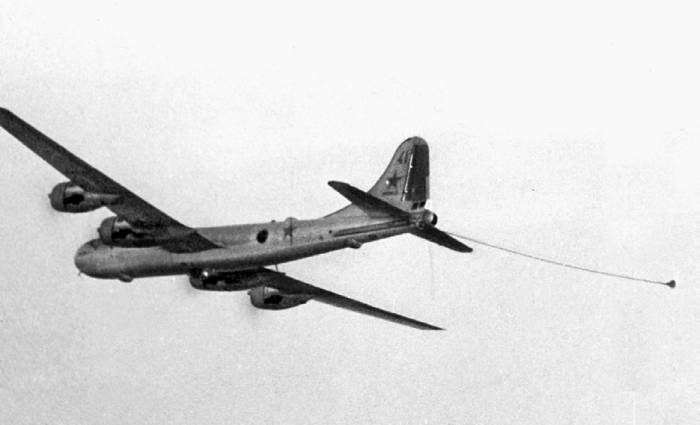
(The prototype probe-and-drogue Tu-4 had been a Burlaki plane. The hosereel was in the former aft bomb bay, and fed through a fairing on the rear left fuselage.)
This method was intended more for the benefit of PVO-Strany (USSR Air Defense Forces, a separate branch of the Soviet military) and their defensive interceptors, and no Tu-4 was considered as a recipient as it was near the end of it’s useful time as a bomber by then.

(The definitive model had two drogue assemblies, carried in wingtip pods. The nub on the former tail gun position was a signal lamp.)
A total of 27 Tu-4s received tanker modifications, either as tankers or recipients.
failed follow-on’s
Two attempts were made to eek more benefit from the WWII “gift”.
The Tupolev bureau started work on the Tu-80 in 1947, just as production of Tu-4 “Bull”s was beginning. In June 1948, the Kremlin approved manufacture of a prototype.

Now free from Stalin’s “exact copy” rule, the Tu-80 moved the cockpit above the crew station and the bombing radar to the nose. The defensive gun turrets were laid flush with the fuselage to reduce drag. The WWII American rubber deicing boots on the wings were replaced by a new Soviet blown air system. The Tu-80 could carry 15% more fuel than a Tu-4 and was designed to be nuclear-capable from the factory.
While the prototype was still being built in 1949, the Tu-80 was cancelled as it was still lacking the desired performance level. Tupolev was allowed to finish the prototype anyways, which flew on 1 December 1949. It was then expended as a target plane.
A much grander affair was the Tu-85 “Barge”. Basically looking like a Tu-80 stretched in every direction, the massive Tu-85 had a wingspan of 183’6″ and a 12-man crew. Maximum takeoff weight was an astonishing 118¼ tons, and it could carry multiple atomic bombs or 20 tons of conventional ordnance. It was powered by four Dobrynin VD-4K engines, possibly the pinnacle of Soviet radial piston designs. Despite its huge size it was 44 kts faster than a Tu-4, and had a ceiling over 38,000′.

(The huge Tu-85.)
In 1951, the USSR ordered the Tu-85 to replace the Tu-4 on all three of its production lines. However in November of that year, the plans were abandoned with only two having been built. The reason was the high losses American B-29s were taking to jets during the Korean War. The Tu-85 was the last piston-powered bomber from the USSR.
a changing threat
During WWII, the only threat B-29s faced over Japan was a limited number of daylight single-seat fighters. By the mid-1950s, the opposition the B-29’s Soviet clone would face was much more daunting.
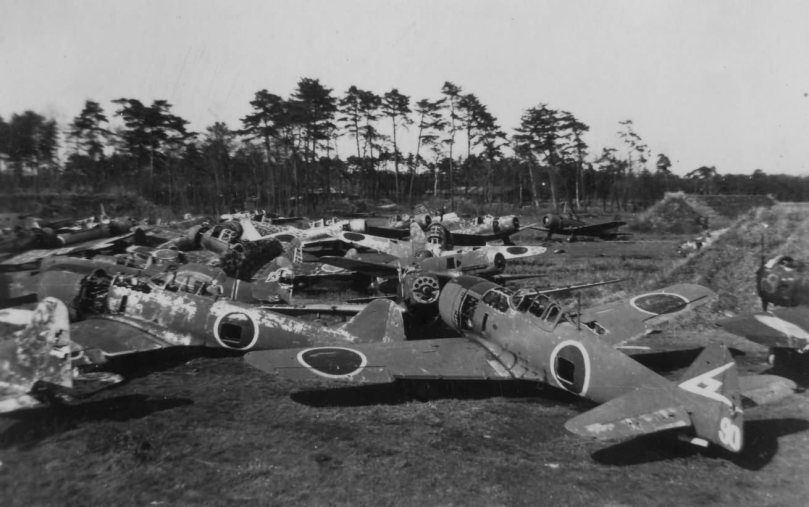
(The Nakajima Ki-84 “Frank” was probably the most dangerous foe of B-29s during WWII. These examples from the Imperial Japanese Army’s 102nd Sentai were destroyed at Chofu after WWII.)

(Five years later, the B-29’s Tupolev clone would have faced F-89 Scorpions; an entirely different level of opposition.)
Northrop’s F-89 Scorpion entered service in 1950. This project originated late in WWII, however there was no desire to finish it before Japan’s defeat and it was intended for the postwar world. This all-weather, day/night plane was designed to slaughter enemy bombers and fired 104 70mm rockets, of which one or two could destroy a Tu-4.
During WWII, the B-29 flew above all but the heaviest Japanese AA guns, which were inaccurate anyways. Starting late in WWII, the United States began to consider guided surface-to-air missiles (SAMs). The Germans were already much further along in this regard and were on the verge of fielding them in early 1945.

(Two German SAM projects of WWII: left, the Rheintochter, and right, the Wasserfall. More than anything, SAMs might have offered Germany a serious way to alter the course and duration – if not final outcome – of WWII. Disposable ordnance that could destroy expensive four-engined bombers at day or night on a recurring 1:1 ratio would have been a notable shift in the air war. The USA gained access to the German work in 1945.)

(The American WWII Lark SAM never entered service.)

(The US Army’s post-WWII MIM-3 Nike Ajax did enter service, and when partnered with interceptors like the Scorpion, it spelled the end of Soviet mass-formation level bombing tactics.)
In 1952, the US Army started the MIM-3 Nike Ajax SAM project, which came online in 1954. The focus of multi-engine strategic bombers with gravity-drop ordnance changed: during WWII, it had been toughness and resistance to damage. Now, speed and ceiling were more important.

(This simple diagram does not consider air density, radar clutter, or layered defenses but none the less illustrates how slant range of 1950s SAMs defending a city played out against airspeed and ceiling. Here at time T¹ the piston-engined bomber can be engaged, but the new faster and higher model can not. At T² both can be engaged. At T³, both can still be engaged but by now the higher & faster new bomber has already passed the drop point (D) of it’s a-bomb, making it irrelevant to shoot down.)

(Tu-4 “Bull” with Tu-16 “Badger”.)
The next Soviet strategic bombers; the Tu-16, Mya-4, and Tu-95; all had superior ceiling and speed. Later still in the Cold War, SAMs improved to the point that traditional high-altitude level bombing was abandoned altogether.
the “Bull” in China

(Re-engined Chinese “Bull”, here fitted out as a mothership for reconnaissance drones.)
Twenty-three Tu-4 bombers and a pair of unarmed trainers were provided to China before the Sino-Soviet split. The first were delivered in early 1953 and later that year, a 10-plane unit inside the PLAAF’s 4th Independent Regiment was operational with the type. This was the only Chinese unit to fly the “Bull”, being based first at Beijing, then Wukung and finally in the 1970s, Nanshui.
The Tu-4 was originally only intended as an introductory type to the Tu-16 “Badger” (which were provided by the USSR in 1957) and then eventually a Chinese-designed strategic bomber. However the Cultural Revolution cost the PRC a decade’s worth of warplane development and in some scientific fields, actually knocked it backwards. Therefore there was no Chinese type and the obsolete Tu-4s soldiered on.
By 1969, the 1940s piston engines were falling apart and between 1970 – 1973, eleven planes were re-engined with WJ-6 turboprops. These continued to be theoretically roled as active-duty bombers; a fairly absurd proposition (consider that the first F-14 Tomcats were being delivered to the US Navy in 1973).

One of the eleven was redesignated KJ-1 and carried the prototype Type 843 AWACS radar. This failed to meet expectations and was not proceeded with.
The Tu-4 was pulled from Chinese bomber service in 1978 and reserve squadron service in 1988, however a few continued flying in test roles until 1991. These were the last B-29 Superfortress derivatives still in active military use anywhere in the world.
It is generally assumed that China never used the type operationally however after the collapse of the Soviet Union in 1991, a retired Russian pilot who had been attached to the project in the 1950s said that Chinese “Bull”s had mounted air raids on minor nationalist-held islets along the Chinese coastline, and that he himself had flown in four of them.
operation “Whirlwind” 1956
The only active Soviet use of the “Bull” came during the failed 1956 Hungarian uprising. A Tu-4 unit was assigned to carpet-bomb Budapest. Because there was fear that NATO might have decided to intervene in the fast-unfolding rebellion while the planes were in the air, they flew an indirect route out of the Ukrainian SSR over Romanian airspace. At their final recall point, roughly 20 minutes from Budapest, the unit was recalled. The tactical situation had shifted so that it would be virtually impossible to avoid hitting Soviet troops on the ground, and moreover the USSR felt the situation could be resolved without seriously damaging the city.
Tu-4D freight carriers, on the other hand, certainly did participate in the operation, ferrying in reinforcements and supplies directly from the Soviet Union. The Tu-4D’s contribution to the mission is often greatly overlooked today.
enduring myths
Part of “General H.H. Arnold Special”s interior had been left unpainted due to a paint shortage at the factory. Supposedly, to stay true to Stalin’s “exact copy” order, every Tu-4 was painted (or rather, partially unpainted) internally as such.
This myth is the most commonly mentioned anecdote of the Tu-4. Otherwise-reputable aviation publications sometimes still repeat it. It is not true. The Soviets were obviously going to change the external markings, so they had even less incentive to duplicate the interior appearance.

(Despite Stalin’s “exact copy” order, Boeing’s decorative yoke ornament was omitted from the “Bull”.)
Early Tu-4s were painted vaguely similar to an American B-29 internally. However this was of no meaning; basically when the team asked Andrei Tupolev what color he wanted the inside to be, he had to pick something.
Another fable – this one actually true – involves cigarettes. During WWII, the US Army allowed airmen to smoke inflight. However Stalin prohibited this of Soviet aircrews. The Tupolev team thus faced a dilemma when they got to the ashtrays of the B-29 being dissected…Stalin’s firm “no smoking” rule vs his firm “no deviations” rule. The solution was that one set of ashtrays was reverse-engineered and made, and put in the plane for state factory inspection. After the inspection, the ashtrays were moved to the next plane in line, and so on.
During the “Bull”s Soviet career, experienced aircrew would amuse themselves by telling rookie airmen outlandish explanations of what the holes in the consoles were for.
end of the road and legacy
As the Tu-4 aged, they were gradually taken out of service and either scrapped or used for other roles. One was modified as the testbest for the “Bee Hind” tail gunnery radar used in later Soviet transports and bombers. Another was expended in a special ground chamber to determine the best angles and calibers to shoot down a B-47 Stratojet (37mm to the wings was determined optimal).

(A Tu-4LL modified with a AN-20 turboprop and a NK-4 turboprop asymmetrically mounted outboard, and the original piston engines inboard.)

(A Tu-4LL testing a prototype jet engine under the belly.)
Others continued flying in very specialized roles. One, the Tu-4TRZhK, was used to transport LOX used in the fuel of early Soviet ICBMs.

(Possibly the most grotesque thing to ever fly, this Tu-4 had the engine, cockpit, and forward fuselage of the Tu-91 “Boot” naval strike plane in place of the right inboard engine.)
The last version of all was the Tu-4UShS, which were used as introductory trainers for non-pilot airmen destined to multi-engine jets.
The Tu-4 left active bomber squadron service in 1959. By the end of 1960 many of the reconnaissance, transport, and test versions were gone as well. The last Soviet Tu-4 airframe in any role, a Tu-4UShS, was retired at the end of 1964.
The reverse-engineering of the B-29 was a phenomenal achievement for Soviet industry, the most bold and elaborate ever successfully completed by any country after WWII. The plane itself gave a huge boost to Soviet airpower at a time when it was very much needed. Beyond that, the bigger prize was the advancements in materials and production, things like synthetic rubbers, analog processors, complex wiring, etc.

(Preserved Tu-4 in the Russian Federation.) (photo by Vitaly Kuzmin)

(In 2013, the CIA declassified its 1958 assessment of the Tu-4 “Bull”.)

Reblogged this on Dave Loves History.
LikeLike
Impressive research!
LikeLiked by 1 person
Fascinating and at times amusing. Also I see you got in a “twofer” on this one, being able to include the German WW2 experimental DFS 346 sailplane jet researched by the Soviets after the war, using the Tu-4 as a mother-ship. Nice touch!
LikeLiked by 1 person
Very engaging read. Thank you.
LikeLiked by 1 person
This gives a great insight into what must have been an incredible journey for the Soviets. To reverse engineer a B29 is no mean feat! Great post.
LikeLiked by 1 person
Nice to see a new post!
LikeLike
Looks like an SVT-40 in the first picture based on where the bolt handle is plus the knife bayonet being under the barrel.
LikeLike
Don’t forget when the red chinese used one to try to start WWIII between the US and the USSR.
That was real Hell & High Water!
LikeLike
Great stuff, and not at all derivative. More, please, sooner.
LikeLiked by 1 person
Great story, fascinating stuff! Many thanks for your thorough research. However, I’m curious to know why the US government did not ask the Sovs / Chinese for their aircraft to be returned, as they must have by then known the location of the planes, and that they were in serviceable condition because the crews were returned home. After all the $billions spent on the B-29 project, surely they would not have wanted any of it to fall into the hands of rivals?
LikeLike
I’d guess they figured the Soviets would obviously say no, and there was no way to make them return the planes, so why go through the motions of asking.
LikeLike
Excellent. I’ve read much about the Tu-4 over the decades, but this is by far and away the best summary.
(please run through your texts and change ‘it’s’ for ‘its’ – possessive pronoun. Mnemonic: you don’t write ‘hi’s pen’, you write ‘his pen’.
Sorry to be so pedantic, but with writing and research so good, this really jars.
LikeLike
An interesting tidbit is that the ASh-73 engine was a cousin of sorts to the Wright Duplex Cyclone. Shvetsov’s design bureau produced the original 9-cylinder Cyclones before WW2, mostly to power the then-new I-16 fighters. All of Shvetsov’s wartime designs, including ASh-73, evolved from the Cyclone-9. No doubt this “family resemblance” helped with the compatibility of the engines, up to a point.
LikeLiked by 1 person
Thank you for a great article.
LikeLiked by 1 person